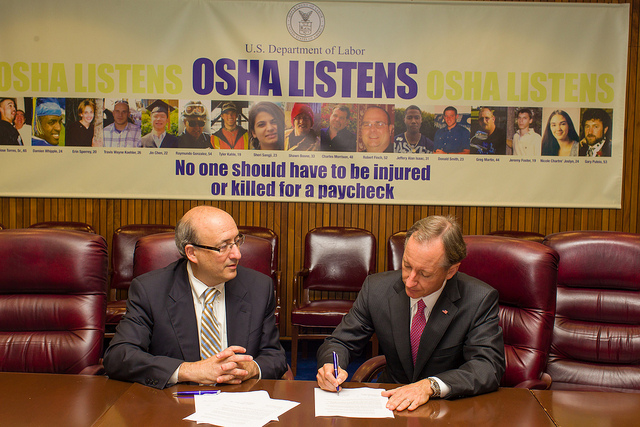The HR/safety director at a large national construction company, who was the first to use OSHA-sanctioned medical exams conducted outside the workers' comp system, said the program is "extremely successful" and may have saved the company as much as $1 million in workers' comp expenses over the past few years.
The company, which has asked not to be named, has had employees sign contracts agreeing to diagnostic tests based on OSHA medical exam regulations. But when the company wanted to us a test result in front of the New York State Workers' Comp Commission, the company's insurance lawyer strongly advised against doing so -- the insurance lawyer told the company lawyer she might go to jail!
The company contacted Ted Ronca, a leading workers' comp and disability attorney and author based in New York. Ronca said a section in OSHA record keeping regulations (attached below) allowed an employer to schedule a contemporaneous exam with a medical provider of its choice, at the same time a worker was being examined as part of the workers' comp process. The employer could then request a release of HIPAA-protected medical records from the worker. Ronca made a written request to OSHA and received an official letter of clarification and refinement, which was noted in my ITL article in October, Has OSHA Become a Friend to Insurers?
Both Ronca (reachable at medsearch7@optonline.net) and I were very surprised to learn of these regulations, which can help an employer push back against any overstatement of the injury done to the worker. But as anyone who has worked in the HR/disability world knows, there is a whole alphabet soup of federal regulations involving both occupational and non-occupational disability programs, including ERISA, SSDI, ADA, FMLA, EEOC, OSHA, DOT and both federal and state workers' comp laws, not to mention scores of management/union-negotiated disability benefit programs. None of these programs are actually aligned with one another. Most are run independently from each other by different federal agencies. And most large employers have different internal staffs and outside vendors or insurance companies that administer these various disability/paid-time-off programs.
A retired New York workers' compensation judge said that uncovering the OSHA regulations was "brilliant" and that state courts wouldn't override them. He said the first thing judges are trained to do is "not touch" any other laws in workers' comp cases. A workers' comp judge would have no authority whatsoever on federal OSHA regulations.
An employer has an unequivocal right to schedule a contemporaneous exam under OSHA record keeping regulations, outside of state workers' comp systems. How and when to use these exams is a whole other matter. Their use is not based on any case law. Case law does not exist here. Usage is based on what Ronca has done with the major construction company and other clients. In fact, OSHA exams are now formerly a part of the construction company's employee contract protocol as a union contractor.
The new employment contract includes all the typical rules and regulations but also contains a provision on how to report all work-related injuries and the requirement that the injured worker must go to a company-provided medical/diagnostic exam, paid for 100% by the employer. In addition, new employees or contractors must undergo a confidential post-hire baseline range-of-motion medical exam, which is not read but kept in a private file and used only if there is a subsequent, work-related injury reported.
Ronca and the company have headed off potentially difficult or fraudulent claims, often without ever going to court, since implementing their program in late 2011. It would typically take as long as 18 months to schedule a hearing or independent medical exam (IME) through the state work comp system. Now, the company can take a very active role from the time of injury.
Among the first test cases was a classic type involving an employee who filed a work comp claim, after being fired, for aggravation of a pre-existing back condition. The OSHA-sanctioned medical exam confirmed there was no aggravation of a pre-existing condition. Furthermore, it was discovered that the employee was working a second job "under the table." No claim was filed.
Ronca says that, depending on results of the OSHA-sanctioned exams, he may be able to tell the employee's work comp attorney, "Your client is a liar." The client and attorney will not show up for a hearing.
In another case, the HR/safety director at the construction company said an attorney at her work comp carrier read the OSHA medical exam report and said, "I have never been so prepared for a hearing." This was another complicated claim involving aggravation of a pre-existing shoulder and neck condition. The carrier was going to settle for $80,000. Instead, the case was settled for $12,000 when it was determined there was no aggravation of the shoulder injury, only of the neck.
Another case in California involved aggravation of a pre-existing condition, where the claimant claimed total disability as a result. The medical exam found a slight aggravation, but the employee refused to return to work. The company went as far to arrange a modified-duty job with the nonprofit Habitat for Humanity, at full pay and benefits, but the employee refused. The company pointed out the situation to the company union. After a 5 1/2-month stand- off, the employee returned to full duty and dropped his work comp claim.
Ronca feels the strongest tool offered by the OSHA regulation is the ability to obtain prior medical records. He also stressed that the whole goal is to get the employer involved in workers' comp claims from the moment of injury. Early intervention is a well-known standard and best practice in workers' comp. An OSHA exam is tool employers may use in selected cases.
The construction company is trying to do the right thing -- that is, get the injured worker an early exam to help determine the correct diagnosis and treatment, which is in the best interest of both the employee and the employer. The OSHA exam should also be used if the employer suspects fraud or abuse, pre-existing conditions, employees working second jobs, etc.
Bob "Red" Hollingsworth, CEO of CompMinder in Salt Lake City, is now using this approach and has updated the CompMinder injury reporting tool he offers to employers. There is now a section that asks the employer if it wants to schedule an OSHA exam? If yes, Hollingsworth (reachable at Bob@buckner.com) has arrangements with a highly qualified occupational medical director to set-up a pre-planned program. It is critical that the employer do this directly with medical providers. The work comp carrier or TPA cannot pay for or schedule such an exam.
The work comp folks can't be involved, so non-believers need not apply. But the employer can!
ADDENDUM -- OSHA REGULATIONS UNDER SECTION 1904
"OSHA record keeping regulations permit an employer to request a prompt medical exam and release of HIPPA protected prior medical records outside the workers' compensation system in order to help understand the link between workplace factors and injuries and illnesses in particular cases."
Key Points
The medical exam must be paid 100% by the employer with the provider of its choice outside the workers' compensation system.
An insurance company or third party administrator cannot schedule or pay for such exams because they cannot act outside the state workers' comp system.
The costs of such medical exams are not included in a company's workers' comp costs nor experience modification calculation.
The employer can choose what medical provider's opinion they consider to be the most authoritative for record keeping purposes.
Employee must submit to a prompt medical exam when requested by the employer and release of HIPAA-protected medical records.
Medical information and records obtained through this process can be discoverable with proper procedure and subpoena in workers' comp cases.
OSHA 300 LOG Recordable Rules-1904
Key Language
In certain circumstances, OSHA record keeping requirements permit an employer to choose between two conflicting medical opinions. When an employer receives contemporaneous recommendations from two or more physicians or licensed health care professionals about the need for medical treatment, the employer may decide which recommendation is the most authoritative and record case based on that recommendation.
1904 Frequently Asked Questions
If a physician or licensed health care professional recommends medical treatment, days away from work or restricted activity as a result of a work-related injury or illness, can the employer decline to record the case based on a contemporaneous second provider's opinion that the recommended medical treatment, days away from work or work restrictions are unnecessary, if the employer believes the second opinion is more authoritative?
OSHA ANSWER IS YES
HOWEVER,
Once medical treatment is provided for a work-related injury or illness, or days away from work or restricted work activity has taken place, the case is recordable.
"If there are conflicting contemporaneous recommendations regarding medical treatment or the need for days away from work or restricted work activity but the medical treatment is not actually provided and no days away from work or work restrictions have occurred, then the employer may determine which recommendation is the most authoritative and record on that basis."
OSHA considers that medical treatment is provided once a prescription is issued.
Key Definitions
Lost-Time: Work day (other than day of injury) when the worker is unable to return to their job.
Contemporaneous: Medical recommendations provided with no change in condition.
Most Authoritative: Best documented, best reasoned and most persuasive
Section 1904.5
Wide variety of issues do not need to be reported on OSHA log 300 but require a medical exam with prior medical records.
Employer can schedule a prompt exam and request HIPAA release for prior medical records.
A carrier or TPA would NOT be permitted to schedule such an exam, because they cannot act outside the workers' comp system.
Note the Department of Transportation (DOT) also has additional exams for drivers such as ability to load, drive etc.
These are known as intermediary exams.
In both cases, exam records and results are not part of the comp record.
Medical exam costs must be paid by employer and are not added in comp claims or the experience modifier. However, with proper procedure and use of subpoena, records may be released and used in the comp claim.
Who Makes the Determination?
OSHA agrees that medical opinions are a burden and impractical and not required in the majority of cases. "This does not mean that employers may not, if they choose, seek advice of a physician or other licensed health care professional to help understand the link between workplace factors and injuries and illness in particular cases. It simply means OSHA does not believe that most employers will need to avail themselves of such professional services in most cases."
Accordingly, OSHA concluded in the final rule that the determination of work-relatedness is "best made by the employer."








